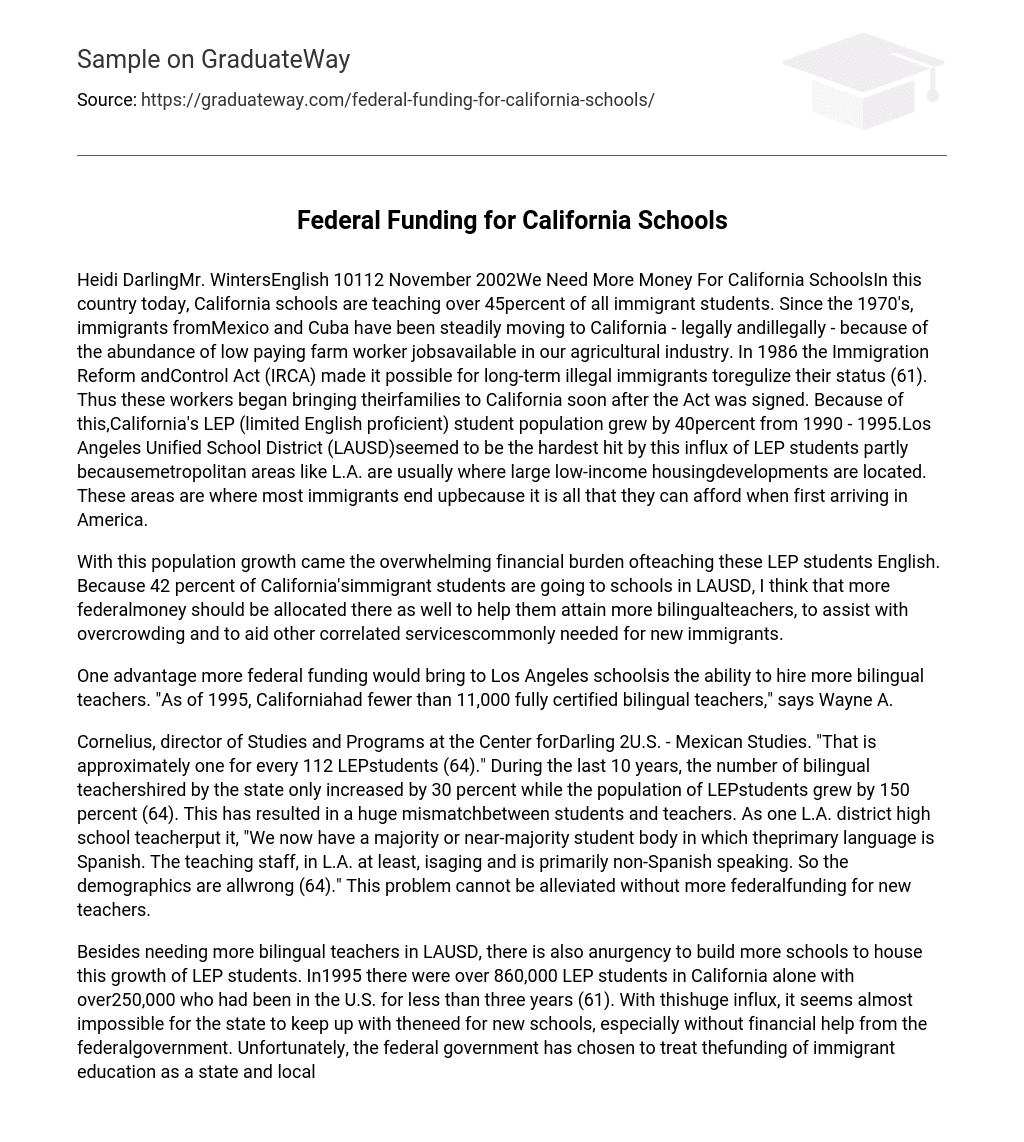We Need More Money For California SchoolsIn this country today, California schools are teaching over 45percent of all immigrant students. Since the 1970’s, immigrants from Mexico and Cuba have been steadily moving to California – legally andillegally – because of the abundance of low paying farmworker jobs available in our agricultural industry. In 1986 the Immigration Reform andControl Act (IRCA) made it possible for long-term illegal immigrants toregulize their status (61). Thus these workers began bringing theirfamilies to California soon after the Act was signed. Because of this,California’s LEP (limited English proficient) student population grew by 40percent from 1990 – 1995.Los Angeles Unified School District (LAUSD)seemed to be the hardest hit by this influx of LEP students partly because metropolitan areas like L.A. are usually where large low-income housing developments are located.
These areas are where most immigrants end upbecause it is all that they can afford when first arriving in America. With this population growth came the overwhelming financial burden ofteaching these LEP students English. Because 42 percent of California’simmigrant students are going to schools in LAUSD, I think that more federal money should be allocated there as well to help them attain more bilingual teachers, to assist with overcrowding and to aid other correlated services commonly needed for new immigrants. One advantage more federal funding would bring to Los Angeles schoolsis the ability to hire more bilingual teachers. “As of 1995, Californiahad fewer than 11,000 fully certified bilingual teachers,” says Wayne A.
Cornelius, director of Studies and Programs at the Center forDarling 2U.S. – Mexican Studies. “That is approximately one for every 112 LEPstudents.” During the last 10 years, the number of bilingual teachershired by the state only increased by 30 percent while the population of LEPstudents grew by 150 percent. This has resulted in a huge mismatchbetween students and teachers. As one L.A. district high school teacherput it, “We now have a majority or near-majority student body in which theprimary language is Spanish. The teaching staff, in L.A. at least, isaging and is primarily non-Spanish speaking. So the demographics are allwrong.” This problem cannot be alleviated without more federalfunding for new teachers.
Besides needing more bilingual teachers in LAUSD, there is also anurgency to build more schools to house this growth of LEP students. In1995 there were over 860,000 LEP students in California alone with over250,000 who had been in the U.S. for less than three years. With thishuge influx, it seems almost impossible for the state to keep up with theneed for new schools, especially without financial help from the federal government. Unfortunately, the federal government has chosen to treat thefunding of immigrant education as a state and local responsibility. “In 1992,” said Cornelius, “Congress even chose to withhold $812 million inpreviously approved federal funding to help heavily impacted states andlocalities pay for immigrants . “. Without the new schools thatare so desperately needed, most likely, a good portion of immigrantstudents will become frustrated and drop out of overcrowded schools, thusincreasing the criminal, welfare and unemployment rates.
In addition to needing federal funding to build new schools, thereare also extra expenses incurred for other immigrant services that schools supply. Not only is money needed for bilingual education in general, but there are also programs such as, ESL (English as a second language), remedial education services, and psychological counseling as well as theadded burden to lunch and after school programs for disadvantaged families. “The immigrant studentDarling 3population is increasing at a time when school budgets are not,” says Cornelius. Without these programs, there will be an increase of pooracademic performances by LEP students, which will lead to higher drop outrates and a lifetime of limited earning opportunities for these students.
Federal funding, in my opinion, is absolutely necessary,especially for overflowing schools in LAUSD, so that they are able to hiremore bilingual teachers, build much needed schools and pay for additionalimmigrant programs. Without this financial assistance, there will likelybe a significant failure at helping these young immigrants to become aviable part of American society. Instead they will become a drain on otherresources such as Welfare, Unemployment and the Criminal JusticeDepartment. As a California taxpayer, I realize that it is difficult tosupport Bonds on election ballots for money to aid inner-city schools, butif more money is not allocated for schools now, taxpayers will be saddledwith higher taxes later on to pay for those other programs. It can only bean advantage to invest in the future of California’s immigrant youth bygaining federal funds to support these badly needed bilingual programs nowand not wait to clean up a larger mess later.
Work Cited
- Cornelius, Wayne A. “Educating California’s Immigrant Children”. (p.60-76).
- The Failure of Bilingual Education. Amselle, Jorge, Ed.
- Center for Equal Opportunity. Washington, DC. 1995. 18 Oct 2002. .





